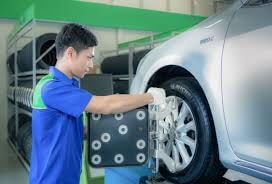Tyre Alignment

Tyre alignment, or wheel alignment, is the crucial step in completing a perfectly completed tyre assembly. Essential to ensure impeccable handling and long tyre life, we tell you everything you need to know about how and when to do it.
What is tyre alignment?
Other terms are often associated with tyre alignment, such as alignment or geometry. These terms do not have the same name but are complementary and are all part of the tyre alignment process.
First of all, geometry consists of checking the inclination of the four tyres of the vehicle so that they respect the indications recommended by the manufacturer and are perfectly aligned, i.e. turned in the same direction. To achieve this alignment, our technicians will take into account three elements:
The toe-in angle comes into play in the parallelism adjustment and corresponds to the inclination of the wheels in relation to the vehicle undercarriage. This inclination is usually directed inwards and is referred to as toe-in, in order to increase stability. However, this may be different in motor sport mode, where the number one criterion is not necessarily driver safety, but rather maximising performance in high-speed cornering, and is referred to as "opening".
The camber angle will play on the inclination of the wheel axis in relation to a perpendicular plane, most commonly the road. We speak of positive or negative camber depending on the angle that has been chosen, to favour straight-line road holding or grip in curves.
The caster angle determines the inclination of the wheel pivot axis, it affects the balance of the vehicle's steering and its behaviour during steering.
The precise measurement of each of these angles is defined to the nearest millimetre, thanks to the know-how and mastery of a specific tool, in this case a geometry bench. Even the best performing tyres will not be able to deliver optimum performance if they are installed in poor conditions. In order not to shorten their service life, the adjustment of these angles is essential.
What are the signs of bad alignment?
Some symptoms may alert you to driving your vehicle:
- Left or right straight line offset
- A steering wheel displaced from its initial axis
- Or squeaky tyres.
Once stationary, also remember to take a look at the tread of your tyres. Abnormal wear can be spotted there. A perfectly balanced and aligned tyre will show even wear over its entire surface. On the other hand, one-sided types of wear on the inside or outside of the tyre are often due to incorrect adjustments. In addition to a control of the vehicle which can be clearly degraded, an inappropriate position of the tyres will lead to an over-consumption of fuel. The tyre will have to withstand more forces exerted on it and will increase its rolling resistance.
As you will have understood, tyre alignment is not to be taken lightly and a scrupulous knowledge of the manufacturer's recommendations is necessary to find the right balance.




